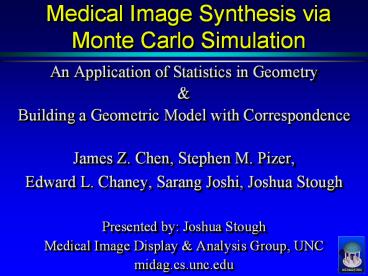Medical Image Synthesis via Monte Carlo Simulation - PowerPoint PPT Presentation
Title:
Medical Image Synthesis via Monte Carlo Simulation
Description:
... warp via FPM landmarks. Volume overlap. optimization ... Landmark Matching Via Large Deformation Diffeomorphisms.' IEEETransactions on Image Processing. ... – PowerPoint PPT presentation
Number of Views:40
Avg rating:3.0/5.0
Title: Medical Image Synthesis via Monte Carlo Simulation
1
Medical Image Synthesis via Monte Carlo Simulation
- An Application of Statistics in Geometry
- Building a Geometric Model with Correspondence
- James Z. Chen, Stephen M. Pizer,
- Edward L. Chaney, Sarang Joshi, Joshua Stough
- Presented by Joshua Stough
- Medical Image Display Analysis Group, UNC
- midag.cs.unc.edu
2
Population Simulation Requires Statistical
Profiling of Shape
- Goal Develop a methodology for generating
realistic synthetic medical images AND the
attendant ground truth segmentations for
objects of interest. - Why Segmentation method evaluation.
- How Build and sample probability distribution of
shape.
3
Basic Idea
- New images via deformation of template geometry
and image. - Characteristics
- Legal images represent statistical variation of
shape over a training set. - Image quality as in a clinical setting.
Ht
4
The Process
James Chen
5
Registration
- Registration Composition of Two Transformations
- Linear MIRIT, Frederik Maes
- Affine transformation, 12 dof
- Non-linearDeformation Diffeomorphism, Joshi
- For all It , It ? Ht(I0) and St ? Ht(S0)
6
Consequence of an Erroneous Ht
James Chen
7
Generating the Statistics of Ht
James Chen
8
Fiducial Point Model
- Ht is locally correlated
- Fiducial point choice via greedy iterative
algorithm - Ht' determined by Joshi Landmark Deformation
Diffeomorphism - The Idea Decrease
9
FPM Generation Algorithm
- Initialize Fm with a few geometrically salient
points on S0 - Apply the training warp function Ht on Fm to
get the warped fiducial points Fm,t Ht(Fm) - Reconstruct the diffeomorphic warp field H't for
the entire image volume based on the
displacements Fm,t Fm - For each training case t, locate the point pt on
the surface of S0 that yields the largest
discrepancy between Ht and H't - Find most discrepant point p over the point set
pt established from all training cases. Add p
to the fiducial point set - Return to step 2 until a pre-defined optimization
criterion has been reached.
10
A locally accurate warp via FPM landmarks
- Volume overlap
- optimization
- criterion tracks
- mean warp
- discrepancy
- Under 100 fiducial
- points, of
- thousands on
- surface
ATLAS
WARP
TRAINING
11
Human Kidney Example
- 36 clinical CT images in the training set
- Monotonic Optimization
- 88 fiducial points sufficiently mimick
inter-human rater results (94 volume overlap)
12
Fiducial Point Model Is an Object Representation
with Positional Correspondence
- Positional correspondence is via the H'
interpolated from the displacements at the
fiducial points - The correspondence makes this representation
suitable for statistical analysis
13
Statistical Analysis of the Geometry
Representation
James Chen
14
Principal Components Analysis of the FPM
Displacements
- Points in 3M-d space
- Analyze deviation from mean
- Example first seven modes of FPM cover 88 of
the total variation.
15
Modes of Variation Human Kidney
16
Generating Samples of Image Intensity Patterns
James Chen
17
Results
James Chen
18
Results
19
Miscellaneous
- National Cancer Institute Grant P01 CA47982
References Gerig, G., M. Jomier, M. Chakos
(2001). Valmet A new validation tool for
assessing and improving 3D object segmentation.
Proc. MICCAI 2001, Springer LNCS 2208
516-523. Cootes, T. F., A. Hill, C.J. Taylor, J.
Haslam (1994). The Use of Active Shape Models
for Locating Structures in Medical Images. Image
and Vision Computing 12(6) 355-366. Rueckert,
D., A.F. Frangi, and J.A. Schnabel (2001).
Automatic Construction of 3D Statistical
Deformation Models Using Non-rigid Registration.
MICCAI 2001, Springer LNCS 2208
77-84. Christensen, G. E., S.C. Joshi and M.I.
Miller (1997). Volumetric Transformation of
Brain Anatomy. IEEE Transactions on Medical
Imaging 16 864-877. Joshi, S., M.I. Miller
(2000). Landmark Matching Via Large Deformation
Diffeomorphisms. IEEETransactions on Image
Processing. Maes, F., A. Collignon, D.
Vandermeulen, G. Marchal, P. Suetens (1997).
Multi-Modality Image Registration by
Maximization of Mutual Information. IEEE-TMI 16
187-198. Pizer, S.M., J.Z. Chen, T. Fletcher, Y.
Fridman, D.S. Fritsch, G. Gash, J. Glotzer, S.
Joshi, A. Thall, G. Tracton, P. Yushkevich, and
E. Chaney (2001). Deformable M-Reps for 3D
Medical Image Segmentation. IJCV, submitted.































